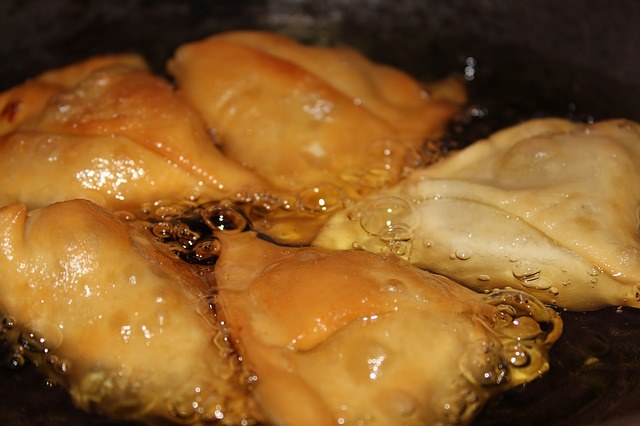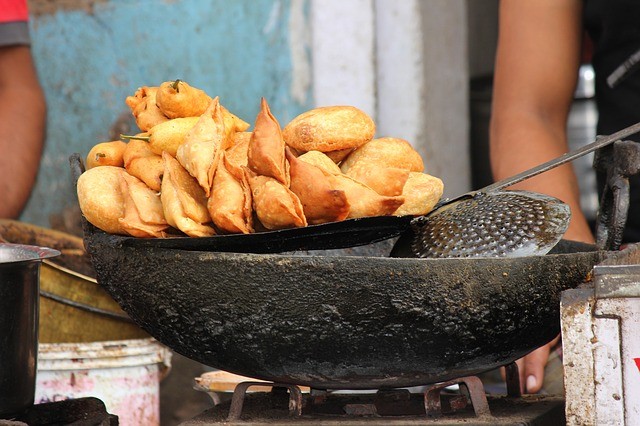Samosas are great treats that can be made either as appetizers for a party or as an entrée in and of themselves.
How does such a simple food manage such versatility, though? This tasty travel food has gone through a number of transformations as it migrated all across the world.
In exploring this “how to make samosas” guide, you’ll be able to see not only the many ways in which samosas can be made, but variations on samosa pastries, fillings, and the ways in which a samosa can be baked.
No matter what your need is, if you’re making a samosa, you’ll be able to cook it up in your own home.
Contents
What Are Samosas?
Samosas have a broad and varied history, but most folks can agree that they were originally made in Central and Southern Asia.
Similar food can be found in other cultures and countries as well, including Egypt and Libya, but Sa’adia Reza of Quartz India takes care to note that the term “samosa” is developed from the Persian word, “sanbosag.”
This varied history, of course, means that samosas can be extremely unique. There is no ‘one’ traditional recipe. So where do you start?
The good news is, there is a general definition of a samosa that most folks can agree on. Samosas, in their basic form, are triangularly-formed, crusty packages full of some sort of delicious filling.
That filling can be sweet or savory, and the dough itself can be as crusty as a person pleases.
How to Make Samosa Dough
According to Felicity Cloake of The Guardian, samosa dough needs to be sturdy enough not only to hold all of the tasty goodness you stuff inside of it, but also sturdy enough to travel.
While Cloake discusses different methods of making your own dough at length – going so far as to recommend that making dough from scratch is the only way to properly enjoy a samosa – you also have the option to use frozen filo pastry for your samosas.
Puff pastry is a secondary alternative, though the texture will likely be airier than a traditional samosa.
Note that the following samosa recipe is incomplete and only follows the making of samosas up until the completion of the dough and the shaping of the samosas, themselves.
Ingredients
- 2 cups of all-purpose flour.
- 1 teaspoon of salt.
- ½ teaspoon of baking powder.
- ¼ cup of olive oil.
- 2/3 cup of water.
Process
- Combine flour, salt, and baking powder together in a sizable bowl until thoroughly mixed.
- In a separate bowl, combine the water and oil.
- Slowly add the oil and water mixture into the dry ingredients, taking care to stir while pouring and taking breaks into order to ensure that the liquid is well combined. The dough, once all the water and oil has been added, should form a single ball but shouldn’t be too smooth. Rather, it should be reasonably shaggy.
- With your hands, knead the dough for 30 seconds to 1 minute, as needed, until the dough becomes smoother to the touch. Once the bulk of the shagginess has been worked away, wrap your dough in aluminum foil or plastic wrap and let it rise at room temperature. Leave your dough for 30 minutes in order to let the gluten form within.
- Once your dough has rested, separate the single ball into smaller balls that are roughly one inch in diameter. Roll out each of these balls individually until they’re thin and form a six-inch circle. Do so until you’ve run out of dough, or until you have as many samosa crusts as you desire.
You’ll want to decide whether or not you’re going to bake or fry your samosas ahead of time, but do note that you can use either method without changing the above recipe. You’ll only need more oil available in your kitchen if you opt to fry your samosas!
Samosa Filling Ideas
Before baking or frying, though, comes filling. While the dough of a samosa has to be strong and flaky, it’s really the filling that matters, because this gives the samosa the bulk of its flavor.
Keep in mind that you don’t want to overfill your samosas at any point!
Start filling your samosas by using about 1 teaspoon worth of filling, while also keeping in mind the varying sizes of your ingredients as well as the different sizes of your homemade pastry.
Meat Samosa Recipe
Meat samosas take extra care to create, in terms of the many variations of samosa that are out there, but they are especially delicious.
If you’re looking for a samosa with a kick and tasty, tasty beef, then consider the following recipe.
Note that the recipe for the dough is not included here, but you can make use of the one listed earlier if you want to go all out on your homemade treats.

Ingredients
- ¾ pound of potatoes, peeled and cubed.
- 2 sweet onions, diced.
- 2 pounds of ground beef.
- 4 tablespoons of vegetable oil.
- 4 cloves of garlic, minced.
- 2 teaspoon of curry powder.
- 2 teaspoon of garam masala.
- 1 teaspoon of Chinese five-spice powder.
- 1 teaspoon of red chilli powder.
- Salt and pepper, to taste.
Process
- Cube and boil potatoes until soft.
- In a separate skillet, combine chopped onion, oil, and garlic until fragrant.
- Once the onions have softened, two to three minutes into the cooking process, add the ground beef, salt, and pepper to the skillet. Cook until brown.
- Drain the mixture in the skillet, then add the remaining spices. Once well combined, add in the softened potatoes and mash until the consistency of the filling resembles mashed potatoes.
- Set the mixture aside on the countertop or in the refrigerator to cool, depending on when you intend to make your samosas.
Vegetarian Samosas
Hindus in Central and Southern Asia who are looking to avoid eating beef have developed a number of recipes that will allow them to enjoy the crunch of a samosa without the meat.
Even if you’re not vegetarian, though, samosas that are packed with vegetables and spices are more than worth the effort to make.
These are also less likely to spill out of your dough packaging because they produce less oil! All the same, some ingredients will still need to be cooked ahead of the actual baking or frying process.
If you’re looking to try a well-spiced and delicious vegetarian samosa recipe, consider this potato and pea option that will throw a party in your mouth!
Ingredients
- ¾ pound of potatoes, peeled and cubed.
- 1 cup of peas, fresh or thawed.
- 1 sweet onion.
- 3 tablespoons of oil.
- 2 tablespoons of parsley.
- 1 teaspoon of grated ginger.
- 1 teaspoon of garlic paste.
- 1 teaspoon of curry powder.
- ½ teaspoon of chili sauce.
- ½ teaspoon of paprika.
- ¼ teaspoon of cayenne pepper.
Process
- Cube and boil the potatoes until soft. If the peas are thawing, add them to the heated potatoes with two minutes left on your cooking time.
- In a separate skillet, mix together oil, sliced onion, ginger, and garlic, and simmer until fragrant.
- After a minute or so, add the chilli sauce, paprika, and curry powder. Cook for an additional one to two minutes.
- Drain the potatoes and peas. Add these to the warm skillet along with the remaining ingredients.
- Smash down the potatoes and peas – not too aggressively, but enough so that they begin to resemble mashed potatoes. Take care to keep the ingredients in the saucepan in motion in order to prevent the mixture from burning.
- After cooking for one to two minutes, remove the mixture from the heat. Place in a separate bowl and let cool in the fridge or on the countertop, depending on when you’re planning on making your samosas.
Here’s a video showing an example of a vegetarian samosa recipe.
Sweet Samosas
Sweet samosas aren’t necessarily filled with Nutella or chocolate, but that doesn’t mean they can’t make excellent after-dinner treats or snacks to have in the middle of the day!
Consider the recipe below if you want to indulge your inner sweet tooth.
Ingredients
- 13 ounces of cream cheese.
- ½ cup of sugar.
- ¾ cup of pistachios, chopped.
- ¾ cup of coconut (optional).
- 1 teaspoon of lime juice (optional).
Process
- Mix the cream cheese until no longer block-like, and smooth. Mix in sugar, but be sure the mixture doesn’t become grainy.
- With a wooden spoon or equivalent, mix pistachios and coconut into the cream cheese.
- Add lime juice and stir until the mixture is well combined.
- Chill mixture until the samosa wrappers are ready and you’re able to fill the samosas appropriately.
Samosas: Bake or Fry?
Determining whether you want to bake your samosas or fry them can depend on a number of factors, not limited to the tools you have available in your kitchen.
Here are both options for finishing off your samosas, and feel free to try both ways in order to determine which method of cooking gives you the flavor and texture you like best!
Frying
Frying is the most traditional method by which samosas are made. Frying any sort of food exposes it to all sorts of delicious fats, meaning that your final product will be both tastier and crispier when finished.
In fact, even though baking samosas has some benefits, it will be difficult to get the same kind of brown coloring if you bake them as opposed to frying them on your stove top.
Frying your samosas is also reasonably straightforward. You’ll want to take the largest of your frying pans – preferably one with a broad rim – and fill it with oil until there’s enough to cover the tops of your samosas.
If you have a thermometer on hand, use it while you bring the heat of the oil and pan up to 350 degrees Fahrenheit.

As a note: you can use whatever kind of oil you like when frying your samosas, but do be aware of how certain oils can change the flavor of your dough.
Avocado oil, for example, won’t necessarily leave your samosas tasting all that strange, but extra virgin olive oil will leave behind a distinct tang that you may not enjoy, especially if you’re making sweet samosas.
While the temperature is rising, be sure to set up a wire rack nearby that you can place the finished samosas on. Deck the racks out with paper towels in order to soak up some of the extra oil.
Once your oil has finally heated to the proper temperature, drop some of your samosas in – but not all at once! Take care to place the seam side of the samosas into the oil first, so as to better seal your filling in its casing.
After about a minute and a half, or once your samosa has started to brown, flip it over and begin to cook the other side. All in all, the cooking time should be between four and five minutes.
Once you’re satisfied with the way your samosas look, remove them from the oil with a spoon or spatula that allows for some of the excess oil to drain away.
Set your samosas on the nearby wire racks and begin your next round of frying.
Baking
Baking your samosas will expose them to less oil, in the long run, and make them healthier for you to eat en mass.
A baked samosa recipe will also serve you well if you’re running low on oil in your kitchen! The taste may not be quite the same as fried samosas, of course, but you should still be able to satisfy your craving with ease.
In order to bake your samosas, don’t worry about altering your recipe in any way. All you have to do is place them on a baking tray and bake them for eight to ten minutes in a 400 degrees Fahrenheit oven.
Once your samosas have started to brown, you can remove them from the oven and cover both sides of the tasty treats with butter, olive oil, or ghee. Don’t eat them yet, though! You’ll want your samosas to cool just a little so their filling doesn’t burn your mouth.
Here’s a video showing an example of a baked samosa recipe.
What’s your favorite samosa recipe?






